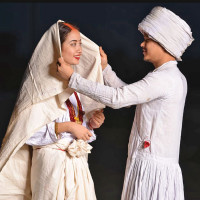- Tuesday, 9 December 2025
Artist Mann creates old rural lifestyle through paintings
Kathmandu, July 14: The advent of modern technology and the strong influence of Western culture have affected the cultures and practices of the indigenous communities, challenging the deeply rooted traditions, lifestyles, and cultural heritage. These changes often come under the guise of progress and transformation.
It is what Artist Mann Gurung has tried to show in his art exhibition, ‘Lost in Transition II, being held at Siddhartha Art-Gallery, Babarmahal, Kathmandu.
The exhibition is the continuation of his 2019 solo art exhibition.
The art-goers can explore 24 intricate artworks by Gurung, which predominantly portray the characters of a rural setting.
Through his artwork, Gurung brings attention to the profound consequences of swift societal changes within remote villages of Nepal. His exhibition not only highlights the urgent need for conserving and archiving the rural lifestyle but also emphasises the significance of transferring this invaluable heritage to future generations.
The exhibition revealed how the once-vibrant indigenous cultures and lifestyles are gradually fading into obscurity.
“The rural lifestyle that we cherished in our childhood, including traditional music, dance, and cultural practices, has been overshadowed by Western influences. If we do not preserve our original culture, it will not be passed on to future generations,” said Gurung.
Gurung embarked on a mission to preserve and document the indigenous culture and lifestyle through painting. He travelled to several villages northern Gorkha along the Budhi Gandaki River.
During his journey, he meticulously collected visual data and depicted the real characters of these villages in his paintings, immortalising their essence for future generations.
He began working on this painting in 2018. He mentioned that at present, some of the characters depicted in his exhibition are no longer.
He used colours dominated by rich brown to depict nostalgia-laden memories through his skillful use of oil painting.
Throughout his visit, he encountered elderly individuals who had become isolated within their modern lifestyles, resistant to any sort of change. In contrast, the younger generation wholeheartedly embraced the new way of life, forgetting their traditional upbringing.
In addition to capturing the essence of rustic living, his paintings vividly portray the profound impact of the armed conflict on lifestyle, particularly the plight of the youth who were compelled to abandon their villages and shifted to cities or foreign countries.
One of the paintings stands out, depicting three generations of females against a background adorned with logos of various remittance companies. This powerful composition symbolises the impacts of the conflict and economic crisis, revealing that the male members have flown overseas, leaving women, elderly individuals, and children back in home in the villages.
Gurung’s artworks provide a glimpse into the bygone rural landscapes. His paintings characterised by pale gray and dark white colour canvases show an old village setting. Gurung skillfully captures the essence of this rustic lifestyle by vividly portraying the features of his characters.
Gurung’s paintings showcase the presence of elderly men, their hands firmly gripping walking sticks, adorned with traditional hats, and carrying bags on their shoulders. His artworks show elderly women wearing socks or plastic slippers, while young women joyfully carry bamboo baskets on their backs. Gurung’s awe-inspiring paintings of young girls beautifully capture their radiant innocence and a curious sense of wonder.
Additionally, it serves as a reminder of the need to preserve Nepali traditional culture and lifestyle, which is at risk because of the unchecked penetration of western cultures.
The art exhibition, which began on June 28, will continue until July 18.

















